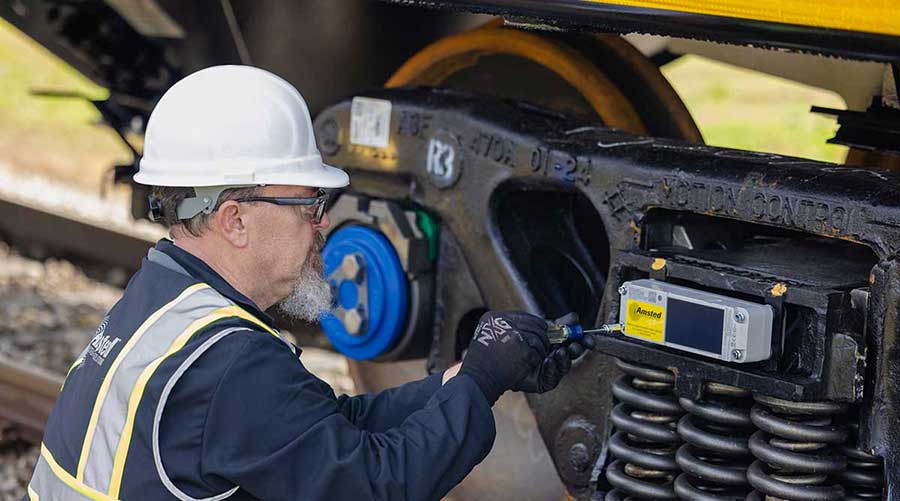Stay updated on news, articles and information for the rail industry
December 2011
Rail News: Short Lines & Regionals
The year ahead, intermodal as royalty and a new high-speed rail outlook report — by Pat Foran (Context, December 2011)
— by Pat Foran, Editor
A story with legs, roots and resonance
As they turn the page on 2011, North American freight and passenger rail execs tell us, soberly and with the requisite cautious optimism, that they expect traffic and ridership growth in 2012 — growth as in slow, slower, slowest. (See our Rail Outlook 2012: Freight Rail and Rail Outlook 2012: Passenger Rail coverage.) Lingering economic and political uncertainty continues to prevent them from nudging the near-term optimism needle any higher.
Not that they're in the glass-is-half-empty camp. They know that in this climate, barely there growth is pretty good — for now. And at the risk of appearing as if I've taken up permanent residence in BrokenRecordville, they also know this: The rail-as-a-growth-industry story has legs, roots and resonance. Rail matters now and it'll matter even more in the years ahead. And that certainty takes the edge off of some of the aforementioned uncertainty. As Regional Transportation District of Denver General Manager Phillip Washington told Assistant Editor Julie Sneider: "I'm optimistic that we'll get through these challenges and create an investment in infrastructure that will be here for the next 100 years."
Similar affirmations framed our annual RailTrends® conference in New York City last month. No, we're not out of the recovery woods yet. And, yes, the inch-by-inch incline we're on has been an anything but enervating ride. But sentiments expressed during the summit suggested there will be no double-dip in the near term, and growth prospects in the intermediate term are real — notably in shale and intermodal. Regarding the latter: "In terms of growth, intermodal is the once and future rail king," notes Tony Hatch, an independent transportation analyst and RailTrends program consultant.
Again, though, rail realmers aren't doing cartwheels or exchanging high-fives. Not with growth this gradual. But they've adjusted their context calipers and tempered the expectation meters. In this no-longer-new normal, they know there will be subplot twists and turns in the rail-as-a-growth-industry story, and they're in it — the shaping and the telling of it — for the long haul. As CN Executive Vice President and Chief Operating Officer Keith Creel told the RailTrends crowd during his presentation: "We're growing our business one carload at a time." Growth as gradual as it gets, then. An interesting read, this story shall remain.
Intermodal: royalty in freight-rail country
Speaking of King Intermodal: Domestic container volume was up, big time, in the third quarter and, despite a stagnant economy and falling diesel prices, overall intermodal volume rose for the seventh-straight quarter, according to the Intermodal Association of North America's (IANA) Intermodal Market Trends and Statistics report released Nov. 7.
Domestic container shipments rose 9 percent year over year to 1.3 million units, a hair above the 8.8 percent and 8.6 percent hikes recorded in 2011's first and second quarters, respectively. All domestic equipment volume rose 6.3 percent to 1.7 million units. But trailer volumes dipped 0.8 percent to 424,987 units compared with third-quarter 2010, possibly due to lower diesel prices, according to the report. International volume dropped as well, by 2.6 percent to 1.96 million units, as many ports posted declines in import volumes. International units handled by rail did not mirror that decline, though, "suggesting that international volume may have gained share from highway movements," IANA said.
Now available: U.S. high-speed rail outlook report
Word choice matters, and nowhere is that aphorism more spot-on relevant than in the U.S. high-speed rail (HSR) realm, where rhetoric is rampant, compounding the challenge to put the program into meaningful context. That's but one nuanced undercurrent in "The Near-Term Outlook for High-Speed and Intercity Passenger Rail in the U.S.," a report researched and written by Progressive Railroading Associate Editor Angela Cotey. She also serves as editor of HSRupdates.com, our subscription-based website dedicated to HSR coverage.
Available as a PDF, "The Near-Term Outlook for U.S. High-Speed Rail" includes insight and analysis on the political climate and upcoming presidential and congressional elections, and how they could impact HSR development; project progress, including updates on the efforts in California and the Northeast Corridor; the long-term funding potential for HSR; and what the federal government could do to encourage private investment in HSR.
The report is available for $39; HSRupdates.com subscribers will receive a copy at no charge. For more information, visit www.hsrupdates.com.


 2025 MOW Spending Report: Passenger-rail programs
2025 MOW Spending Report: Passenger-rail programs
 Gardner steps down as Amtrak CEO
Gardner steps down as Amtrak CEO
 Guest comment: Oliver Wyman’s David Hunt
Guest comment: Oliver Wyman’s David Hunt
 Women of Influence in Rail eBook
Women of Influence in Rail eBook
 railPrime
railPrime






